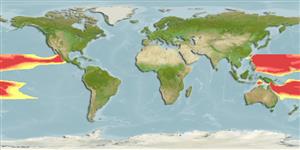>
Stomiiformes (Lightfishes and dragonfishes) >
Stomiidae (Barbeled dragonfishes) > Melanostomiinae
Etymology: Eustomias: Greek, eu = good + Greek, stoma = mouth (Ref. 45335).
More on authors: Johnson & Rosenblatt.
Environment: milieu / climate zone / depth range / distribution range
Ecología
marino batipelágico; rango de profundidad 0 - 1100 m (Ref. 11333). Deep-water; 25°N - 30°S
Pacific Ocean: between 10° and 25°N and between 20° and 30°S.
Tamaño / Peso / Age
Maturity: Lm ? range ? - ? cm
Max length : 15.6 cm SL macho / no sexado; (Ref. 11333); 14.6 cm SL (female)
Short description
Morfología | Morfometría
A single, cone-shaped terminal bulb 0.9-1.5% SL except in the smallest specimen. Barbel relatively short 25-52% SL except in specimens smaller than 7 cm. A single, simple or bifurcate, short terminal filament 5.1-1.6% SL, decreasing relatively with growth. Proximal end of bulb almost flat, with a solid black cap. Axis of stem moderately to lightly pigmented. No spot usually at the base of both. External chevron-shaped or roundish striated areas unpigmented. Middorsal paired spots between occiput and dorsal-fin origin 8 (rarely 9) (Ref. 11333).
Mesopelagic at 50-800 m (Ref. 58302). Environment and actual depth range needs verification.
Life cycle and mating behavior
Madurez | Reproducción | Puesta | Huevos | Fecundidad | Larva
Gibbs, R.H. Jr., T.A. Clarke and J.R. Gomon, 1983. Taxonomy and distribution of the stomioid fish genus Eustomias (Melanostomiidae), I: subgenus Nominostomias. Smithson. Contrib. Zool. 380:139 p. (Ref. 11333)
IUCN Red List Status (Ref. 130435)
Threat to humans
Harmless
Human uses
Más información
Nombres comunesSinónimosMetabolismoDespredadoresEcotoxicologíaReproducciónMadurezPuestaAgregación para la puestaFecundidadHuevosEgg development
Age/SizeCrecimientoLength-weightLength-lengthLength-frequenciesMorfometríaMorfologíaLarvaDinámica larvariaReclutamientoAbundanciaBRUVS
ReferenciasAcuiculturaPerfil de acuiculturaRazasGenéticaElectrophoresesheritabilidadEnfermedadesProcesamientoNutrientsMass conversion
ColaboradoresImágenesStamps, Coins Misc.SonidosCiguateraVelocidadTipo de nataciónSuperficie branquialOtolitosCerebrosVisión
Herramientas
Special reports
Download XML
Fuentes de Internet
Estimates based on models
Preferred temperature (Ref.
123201): 8.9 - 20.5, mean 15.3 °C (based on 9 cells).
Phylogenetic diversity index (Ref.
82804): PD
50 = 0.5000 [Uniqueness, from 0.5 = low to 2.0 = high].
Bayesian length-weight: a=0.00302 (0.00117 - 0.00783), b=3.12 (2.89 - 3.35), in cm total length, based on LWR estimates for this (Sub)family-body shape (Ref.
93245).
Nivel trófico (Ref.
69278): 4.3 ±0.8 se; based on size and trophs of closest relatives
Resiliencia (Ref.
120179): Medio, población duplicada en un tiempo mínimo de 1.4-4.4 años (Assuming tmax>3).
Fishing Vulnerability (Ref.
59153): Low vulnerability (10 of 100).
